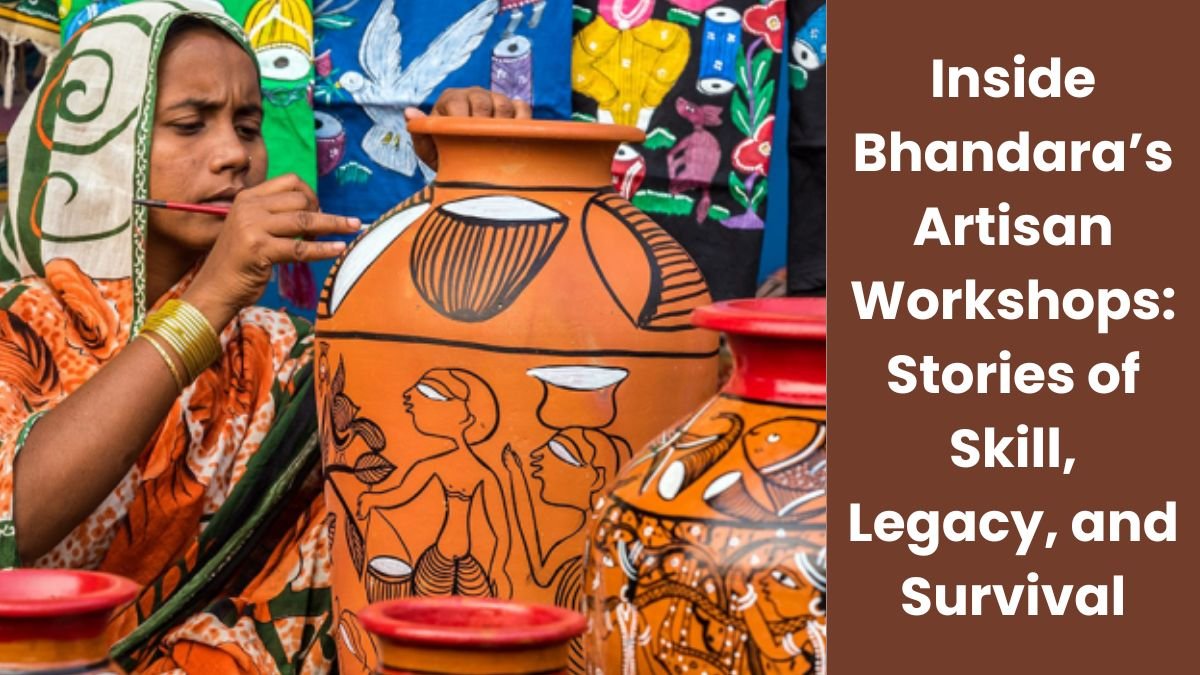Introduction: Bhandara this district of Maharashtra is often known for its natural beauty and cultural diversity. But very few people know that within the lanes and villages of this peaceful region are hidden some small workshops, where history, tradition and skill are molded into new forms every day. These workshops are not just places of production, but a powerful testimony of life.
Every hammer blow, every thread weave, every wood carving has a story hidden in it—sometimes of struggle, sometimes of respect, and most of the times—of holding on to life. Let us go inside these workshops of Bhandara and know the lives of those artisans who create history with their hands.
The magic of hands that has been going on for generations
Narayan Thackeray, who lives in a small village of Bhandara, works as a wood carver. This tradition has been going on in his family for 5 generations. In the backyard of his house is a small workshop, where the soft sounds of wood carving can be heard.
“When I was a kid, my grandfather used to have foreigners come to him to buy handmade idols. Those days are gone, but I don’t want my ancestors’ art to die,” says Narayan.
His eyes are sparkling, but his voice betrays the weariness of financial hardship.
Art made of clay, water and soul
Some women in Bhandaara are still carrying on the tradition of pottery-making. Like Savitri Bai Meshram, who brings clay from outside the village every morning and turns pots on the wheel until noon.
Her workshop is just an open courtyard, where she, her two daughters-in-law and granddaughter work.
“Now people buy steel and plastic pots, but the soul in our handmade things cannot be achieved by machines,” says Savitri Bai.
Listening to them, it feels as if the soil also breathes.
Clothes that cover not only the body but also the tradition
- In the Nandpur area of Bhandara, some families do traditional weaving and dyeing of clothes. Especially clothes decorated with ‘Warli’ and ‘Gond’ artwork are made here.
- Weaver Suresh Kavre says, “We do not weave clothes, we weave stories. Every color, every design is associated with some folklore or faith.”
- These clothes are now being sold on online platforms as well, but the main problem is that the younger generation is not taking interest in this work.
There is skill, but no support
- These artisans of Bhandara are proficient in their respective skills, but they are in dire need of market, technical assistance and government support.
- 60-year-old craftsman Ramesh Shende says, “If we get training in designing and the facility to sell online, then our work can get recognition.”
- According to him, the local administration has promised several times, but no concrete plan has come to fruition till date.
There are some new hopes too
- In recent years, some youngsters have returned to their villages and tried to combine traditional crafts with a modern approach.
- Ritesh Deshmukh, an engineering graduate, is now making bamboo products with his family.
- “I saw that the bamboo swings made by my grandfather were still intact even after 10 years. I thought, if quality and design are combined, then this can become a brand.”
- Ritesh has started a website and also promotes his work on Instagram. Today, he gets orders from many parts of Maharashtra.
Empowerment of women artisans
- The women of Bhandara are no longer limited to just household chores. Now they are becoming self-reliant on the basis of their skills.
- Rekha Yadav, a member of a self-help group ‘Srujan Samuh’, says, “We are 15 women who make handmade diyas, rangoli sets and rakhis. Our profits double during festivals.”
- With the training and loan schemes provided by the government, this group is moving towards self-reliance.
What is being lost and what can be saved?
These artisan workshops may be small, but they contain a vast sea of culture. But if they do not get support in time, this knowledge, this tradition and this history can be lost forever
- Organizing exhibitions and fairs at the local level
- Digital training for online sales
- Scholarship and internship programs to connect the youth
- Transparent and timely access to government schemes
Conclusion:
The stories of the artisans of Bhandara are not just an example of craftsmanship, but of the will to live. Those people who did not bow down to time, circumstances and technology – but challenged time with their work.
